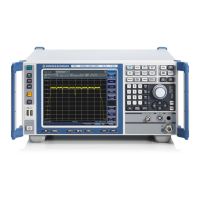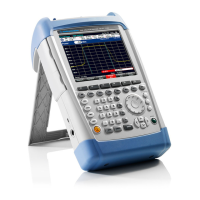Remote Control
R&S
®
FSVA/FSV
594Operating Manual 1176.7510.02 ─ 09
You can read out the register with STAT:QUES:COND or STAT:QUES:EVEN.
Table 4-6: Meaning of the bits used in the STATus:QUEStionable register
Bit No. Meaning
0 - 2 Unused
3 POWer
This bit is set if the measured power level is questionable.
The STATus:QUEStionable:POWer Register provides more information on the error type.
4 TEMPerature
This bit is set if the temperature is questionable.
5 FREQuency
This bit is set if there is anything wrong with the frequency of the local oscillator or the reference
frequency.
The STATus:QUEStionable:FREQuency Register provides more information on the error type.
6 - 7 Unused
8 CALibration
This bit is set if the R&S FSVA/FSV is unaligned ("UNCAL" display)
9 LIMit (device-specific)
This bit is set if a limit value is violated.
The STATus:QUEStionable:LIMit Register provides more information on the error type.
10 LMARgin (device-specific)
This bit is set if a margin is violated.
The STATus:QUEStionable:LMARgin Register provides more information on the error type.
11 SYNC (device-specific)
This bit is set if the R&S FSVA/FSV is not synchronized to the signal that is applied.
The R&S FSVA/FSV is not synchronized if
●
it cannot synchronize to midamble during a measurement or premeasurement
●
it cannot find a burst during a measurement or premeasurement
●
the results deviate too much from the expected value during premeasurements
12 ACPLimit (device-specific)
This bit is set if a limit during ACLR measurements is violated.
The STATus:QUEStionable:ACPLimit Register provides more information on the error type.
13 Not used
14 Digital I/Q (device-specific)
This bit is set if a connection error occurs at the R&S Digital I/Q Interface (R&S FSV-B17
option), see "STATus:QUEStionable:DIQ Register" on page 595
The STATus:QUEStionable:DIQ Register provides more information on the error type.
15 This bit is always 0.
STATus:QUEStionable:ACPLimit Register
The STATus:QUEStionable:ACPLimit register contains information about the results of
a limit check during ACLR measurements.
Remote Control - Basics

